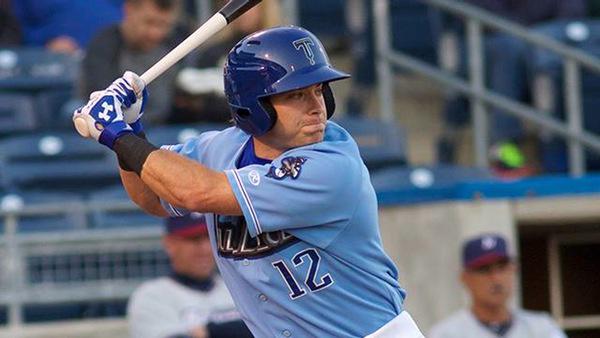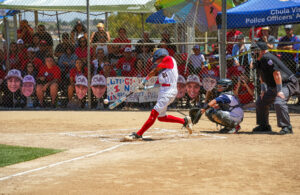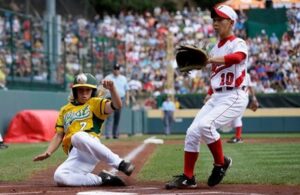Will Taylor Featherston Stick With The Angels?
- Updated: February 26, 2015

After trading Howie Kendrick to the Dodgers for Andrew Heaney, second base is a question mark for the Los Angeles Angels. They acquired Josh Rutledge in a winter trade, and he’s the presumptive starter at second ahead of some other less-than-inspiring options, especially when compared to the departing Kendrick. But one man that remains a mystery is Taylor Featherston, a middle infield prospect the Angels nabbed in the Rule 5 draft from the Rockies.
For those unfamiliar, a quick Rule 5 primer: players drafted in the Major League portion of the Rule 5 Draft, which happens every December, must stay on the active 25-man Major League roster the entire next season, or else they must be offered back to their original team. Those eligible to be drafted are minor leaguers not on their organization’s 40-man roster.
The players aren’t allowed to “hide” on the disabled list, either, as they still must be active for at least 90 days on a big league club’s roster or else, again, they must be offered back to their original organization. The original club then can either accept the player, or seek financial compensation ($25,000) and relinquish their claim to him, now property of his new organization.
Featherston, who will turn 26 in October, was a Rockies farmhand originally drafted in the 5th Round in 2011 from Texas Christian University. He was both a midseason and postseason All Star at AA Tulsa in 2014, slashing .260/.322/.439 and splitting time between second base (72 games) and shortstop (39 games). Considering the Rockies have Gold Glove talent blocking him at second, short, and third base, though, he’s no doubt happy to be out of that organization.
![Featherston representing the Rockies in the Arizona Fall League [Image via @MLBPipeline]](http://www.calisportsnews.com/wp-content/uploads/2015/02/B4rW7Y2CYAAmEiY-267x300.jpg)
Featherston with the Rockies in the Arizona Fall League [Image via @MLBPipeline]
Based on his minor league numbers, it would be difficult to justify starting him 150 times at second this season (though, not according to some); at least early in the year, he ought to be put in low-leverage situations. And, if he whiffs at a higher percentage while losing the power he has shown in the minor leagues, Featherston will likely be returned to Colorado, especially considering the Angels other second base options (more on that below).
But, if he can show power at second and provide better defense than the team’s other options (not necessarily that difficult), he could justify the roster spot and become a diamond in the rough as his career develops.
So which Featherston will the Angels get this season? Do they have a rent-a-player for part of the year, or are they looking at a potential second baseman of the future? As you might expect, history suggests varying degrees of success in the Rule 5 Draft.
![Jose Bautista [Image via @bluebirdbanter]](http://www.calisportsnews.com/wp-content/uploads/2015/02/B-nIgiDWwAAAId8.jpg)
Jose Bautista [Image via @bluebirdbanter]
On the flip side, Johan Santana was in the Marlins organization in 1999 when he was taken by the Astros in the Rule 5 Draft, and immediately traded to the Twins. Minnesota hid 21-year old Santana in their bullpen in 2000, appearing in 30 games in a full season that year, whereas the Twins’ five other full-season relievers each pitched more than twice as often: LaTroy Hawkins (66 games), Bob Wells (76), Hector Carrasco (61), Travis Miller (67) and Eddie Guardado (70). Used about every fifth day (as a reliever!), Santana put up ugly numbers: a 6.59 ERA and 1.814 WHIP, allowing 102 hits and 54 walks in 86 innings. But obviously, the Twins saw long-term potential that was enough to warrant an ugly and slow rookie year, and it certainly paid off over the next several seasons.
While there are many Rule 5 picks every year (including some that work, and some that don’t) I’ve chosen Bautista and Santana for a reason. Bautista failed to stick with the Orioles (and Devil Rays and Royals) because they couldn’t figure out how to effectively hide him on the bench; he received just 12 PAs in the Orioles’ first 33 games before they cut him loose, got 16 PAs as a member of the Devil Rays for 17 games, and then got just 25 PAs across 25 games with the Royals before finally being offered back to the Pirates. He spent the entire season on active Major League rosters, and only got 96 plate appearances.
That’s the thing: he wasn’t good. Bautista slashed .203/.263/.239 in those 96 PAs with no home runs, two RBIs, and 40 strikeouts (a 41.7% rate!). It’s difficult to justify an inexperienced A-ball outfielder taking up a 25-man roster spot when he’s completely ineffective to the point of hurting your bench depth, even in the DH-driven American League. Santana, like Bautista, played both poorly and sparingly, but the biggest difference was that the Twins had five regular relievers and were content letting him mop up once a week; he pitched only three times the entire month of May.
![Johan Santana [Image via @TwinkieTown]](http://www.calisportsnews.com/wp-content/uploads/2015/02/B742M6HIcAAhSt0.jpg)
Johan Santana [Image via @TwinkieTown]
For Bautista in Baltimore, Jay Gibbons, Luis Matos and Larry Bigbie took most outfield starts in 2000, but only Bigbie put up decent numbers (including 2.1 Wins Above Replacement) while Matos (-1.1 WAR), Gibbons (0.5), and back-ups Karim Garcia (-0.7) and Tim Raines, Jr. (0.6) left more to be desired in the outfield. Without going lineup-by-lineup, the same can be said for Tampa Bay, Kansas City, and Pittsburgh that year. Bautista was bad, but he was part of bad outfields in all four big league stops which made it impossible to justify keeping him on the active roster behind already underperforming starters.
For Santana, the Twins let him eat a roster spot on their dumpster fire of a 69-93 team. But, unlike Bautista in 2004, the 2000 Twins had the depth to hide Santana. The above-mentioned five relievers picked up 374.2 relief innings across 340 appearances of fairly effective baseball (well, as effective as you can be for the worst team in the American League). That took the pressure off Santana and allowed the Twins to stash him on the active roster all season.
An ideal situation for Featherston, who has seen significant time at both shortstop and second base in the minors, would be as a utility infielder backing up shortstop Erick Aybar and second baseman Kendrick. The problem, of course, is that Kendrick is no longer on the team. While Aybar figures to be a mainstay again at short, second base is a black hole where underwhelming options abound: Rutledge, Johnny Giavotella, and Grant Green. To put it bluntly, Giavotella doesn’t hit, Green doesn’t field, and presumptive starter Rutledge doesn’t hit or field as evidenced by, among other things, a career 21.0% strikeout rate and -2.8 defensive WAR.
![Featherston with his former club. [Image via @purplerowBK]](http://www.calisportsnews.com/wp-content/uploads/2015/02/B2aFyosIMAApcKB.jpg)
Featherston with his former club. [Image via @purplerowBK]
Rule 5 picks tend to work best when you can “hide” them on the roster behind effective (or at least, good-enough) starters. Santana, while ineffective on the mound, was hidden in a decent bullpen on a bad team. Bautista was not only ineffective himself, he also played on teams with poor production from starters at his position, and couldn’t be hidden all season in either Baltimore, Tampa Bay, or Kansas City.
Taking Featherston’s AA peripherals into account (high strikeouts, mediocre average and OBP, low walks), he will find himself like Bautista in 2004: ineffective on a big league roster with ineffective starters in front of him, making it hard to justify his roster spot all season. Added to this, no less, is the fact that he’ll be on a team with much higher expectations than those Bautista and Santana played for in their Rule 5 years.
If the Angels had kept Kendrick, or had a better starting option at second base, Featherston would be a great Rule 5 addition who could hide as a utility infielder and play sparingly off the bench all season on a strong team. But through no fault of his own, stuck with Rutledge, Giavotella, and Green as the options at second, there’s nowhere to hide. Angels general manager Jerry Dipoto simply hasn’t put Featherston in a position to succeed after being acquired.
The Rockies changed AAA affiliates this offseason, taking over Albuquerque from the Dodgers. I don’t think it’s too much of a stretch to expect to see Featherston back with the Isotopes this summer. In other words, 2015 Featherston will look more like 2004 Bautista than 2000 Santana. Let’s just hope for his career that the Rule 5 Draft won’t delay his development as much as it did to Jose Bautista.
Stay with us at Calisportsnews.com as we will keep you up-to-date on all things Los Angeles Angels and the rest of the LA sports teams! All Cali, All the time!



